#and I thought that idea sounded funny enough to make a semi-compelling short story
Text
Ranking : John Carpenter (1948 - present)

If one were to name off ten American directors from the past half-century or so in rapid fire fashion, I’d be willing to put money on the table that a vast majority would have the name John Carpenter on that list. His impact on horror, suspense and psychological thriller films is undeniable, and his prolific ability to score his films with iconic music he creates puts him in the realm of legends. For a director that dwells in the areas usually set aside for disposable box office fodder, it is surprising that at least five of his films (and possibly more, depending on who’s doing the debating) could be consider bonafide classics.
Perhaps the most interesting thing about putting this list together was the discovery and true understanding of just how much range that Carpenter is capable of, even if his films are distinctly his both in terms of genre-based elements and directorial style. When it comes to the films Memoirs of an Invisible Man (a personal favorite from my pre-teen years) and Starman, I didn’t even realize they were John Carpenter films because they were so different from what I’d come to know him for. Revisiting the films I was familiar with gave me great joy, and taking in the films I’d overlooked or passed on gave me a deeper understanding of John Carpenter not only as a creative spirit, but as a man trying to stake a claim to his voice in an industry famous for conformity.
With that being said, I took all eighteen of John Carpenter’s feature length films and ranked them in terms of my personal enjoyment and opinion. As always, the floor is open for discussion, so feel free to share your thoughts and open up a dialogue, and enjoy!


18. The Ward (2010)
I’m going to be 100% honest with you all… coming in to this list, I pretty much had already decided that Ghosts of Mars was going to anchor this list. Fifteen movies in, it felt like my prediction would come to be. But then, something funny happened… The Ward showed up in my mailbox courtesy of Netflix DVD. I watched the film, and so many other films came to mind : Girl, Interrupted… One Flew Over the Cuckoo’s Nest… Shutter Island… Session 9… Unsane… The Jacket… the list goes on and on. That’s the thing about this film… nearly 40 years in, the last thing you’d expect John Carpenter to be is derivative. The Ward really wants to be an asylum thriller, a revenge-based ghost story and a period piece, but it never really commits to any of its aspirations, and what we’re left with is 90 minutes of Amber Heard, and in an information age obsessed with cancel culture, what’s going on in her personal life is infinitely more compelling than what she’s going through in The Ward. There are some good shots of fire in the film, and Mamie Gummer is acting circles around everyone she shares the frame with, but otherwise there’s not much to this one. Hopefully this won’t be the last film of Carpenter’s career.


17. Ghosts of Mars (2001)
If nothing else, Ghosts of Mars is an ambitious film. What it lacks in coherency, it makes up for in its amalgamation of ideas. The film is all at once a prisoner transport film, a film about a team of crack operatives, a film featuring a revolt and a tale about respecting the land that you intend to exploit for its resources. It sets itself up to be a John Carpenter take on Rashomon, with a number of stories being told through a singular unreliable narrator (due to the lack of those left to tell their own story). While there are some good ideas present in this film, not to mention some wonderful examples of non-traditional casting for an action movie, Ghosts of Mars falls short in its need to be everything to everyone. The film has garnered a cult following since its release, but as someone who saw this in theaters during its initial run, it still doesn’t do it for me.


16. Vampires (1998)
If From Dusk till Dawn isn’t enough to satisfy your Vampire Western cravings, then I humbly submit to you John Carpenter’s swing at the mixture in the form of Vampires. All the earmarks of both genres are present : a crack team of experts hit hard and early, an undercurrent of religion that neither praises nor damns it, a seemingly insurmountable antagonist with a single-minded blind focus, and even a damsel in distress forced to rough it with the roughnecks. Like many of his films, the Carpenter score plays unofficial star against the bananas series of events laid out. Speaking of crazy events, leave it to the likes of James Woods and Daniel Baldwin to take what could be best classified as pulp material and elevate it into the realms of honest entertainment. While not as flashy or fantastic as some of his previous films, the special effects work is effective (no pun intended), with a nice batch of memorable kills sprinkled throughout the film. If this film would’ve been made in the 1980s, I would argue that it could’ve been timeless, but unfortunately, it screams of the 1990s in all the ways that make a film dated, which is even funnier when you consider it was released near the end of the decade. Vampires is fun, but I’d be lying if I called it a classic.

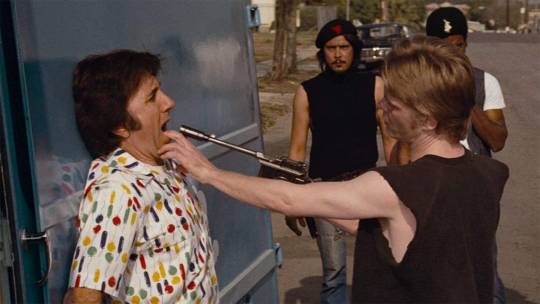
15. Assault on Precinct 13 (1976)
Assault on Precinct 13 marks the proper feature debut for John Carpenter, with Dark Star essentially being a glorified student film. Interestingly enough, the film has a ton of representation across the board in its casting, making it one of the more diverse films released on a major level with its Black lead and strong supporting cast featuring women, Black and Hispanic actors/actresses. At the time the film was released, the gang problem was going from an underground and isolated situation to more of a widespread panic, and Assault on Precinct 13 provides plenty of subtext in terms of how gangs are viewed, the perception of their impact on the community and, most importantly, their everlasting struggles with the police. Speaking of the police, there are some subtle jabs at the inept practices of police in terms of administration and the way the handle prisoners, all of which lead to a perfect storm of despair for our protagonists.


14. Escape from L.A. (1996)
This film marked the final collaboration between Kurt Russell and John Carpenter, and what an odd one to finalize such a rich and fruitful collaborative relationship. There are some things about the film that definitely work… Snake Pliskin is (and always will be) magic on the screen. Los Angeles certainly had the landmarks and the culture suitable for stylizing into a post-apocalyptic labyrinth of dangers. The statements the film makes on the moral majority and the isolation of people over cultural and ideological differences works as a harbinger for what could be in an extreme example, and has only become more relevant as time has passed. That being said, this film seems to not know whether it wants to be a comedy on the sly, or whether it’s just accepting of taking the often occasional odd detour for seemingly aesthetic purposes, which makes sense when one realizes that the film spent a decade in development hell simply because Carpenter was afraid to pull the trigger on a script he felt was “too light, too campy”. While a departure in comparison to Escape from New York, and definitely a tonal shift from the vast majority of the Carpenter films, it does have its moments… unfortunately, the moments are not frequent enough to put this one in the upper echelon of Carpenter’s work.

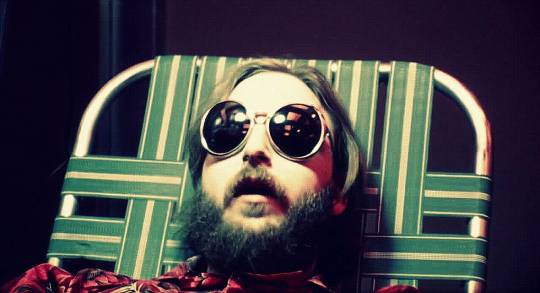
13. Dark Star (1974)
For a debut film, Dark Star already had enough elements to be distinctly John Carpenter… the use of an ensemble cast, DIY special effects, a John Carpenter score, and hilariously, a Kurt Russell facsimile in the form of Cal Kuniholm. Oddly, this is really the only proper science-fiction film in the Carpenter canon (outside of the flop turned cult semi-classic Ghost of Mars), with several pieces of machinery requiring voice casting due to their intelligence and autonomy. Dark Star is also unique within the Carpenter legacy due to its reliance on wit, logic and humor more so than star power and wild premises, making it one of the more cerebral films made by Carpenter. On a personal note, my old friend Thomas spent YEARS trying to get me to watch this film, and after finally taking the time to do so, I’d love to have those years back to commit to the fandom of this film. It’s sadly been a bit lost to time, but it’s one of the John Carpenter films that I like to recommend the most, as it definitely deserves to be remembered.


12. The Fog (1980)
After a massive hit like Halloween, I’m sure expectations from viewers and critics alike was sky high. With his follow-up after his first foray with fame, John Carpenter released The Fog, a supernatural affair with a much more deliberate pace than anything he’d previously released. Perhaps it was this slower, more methodical approach, combined with an extremely powerful use of subtle practical effects, that makes The Fog feel more like an uneventful slow burn than it actually is. More so than any film he’d released previously, The Fog pulls you in over your head into its tone and mood, and while nothing much on the fantastic side occurs, there are levels to visual stimulus used to engulf viewers in an emotion matching those within the world of The Fog. The sound design for The Fog does a great bit of the heavy lifting as well, which is something that should be noted, as it is some of the best work in that realm that Carpenter and company executed for any of his films. A subtle masterpiece, but it feels like the victim of being made on borrowed time, kind of like an album made by a band while in the midst of touring their breakout release.


11. Prince of Darkness (1987)
In-between two of John Carpenter’s most outstanding and wonderfully outlandish offerings came Prince of Darkness, a deeply methodical slow burn that parks itself firmly in the intersection of science and religion and mines it for horrific fodder. Tinges of science fiction, mystery, horror, espionage and the supernatural are all working in tandem to create a literal house of horrors filled with intellectuals blind to the proof right in front of their eyes. As the midpoint of Carpenter’s self-appointed Apocalypse Trilogy (which also features The Thing and In The Mouth of Madness), it certainly continues the tradition of unfolding mysteries and threats that transition from vessel to vessel. Carpenter’s score is doing overtime in terms of setting the mood, nearly establishing itself as a physical presence in the manner that it accents what is presented visually, and the use of color is a bit more expressive than what is normally found in the Carpenter production style. The insect motif is also a nice touch, as it serves to literally make your skin crawl moments before traditional scares occur.

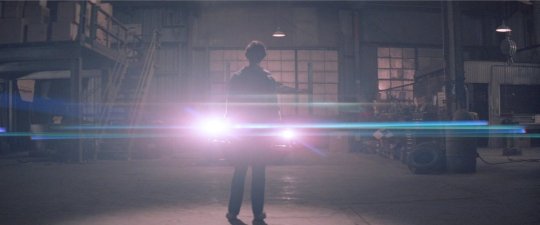
10. Christine (1983)
On paper, the combination of a Stephen King story told through the lens of John Carpenter sounds fantastic, and Christine is definitely the type of Stephen King story that can fit the Carpenter bill. Being a teenager can be a frustrating section of life, and for the vast majority, the day that you own a car symbolizes an important step towards maturity and freedom. Stephen King took this ages old scenario and made it a deeper story about finding yourself outside of the protection and orders of others (be it dictator parents, picture perfect friends or a possessed vehicle), and John Carpenter picks up on every nuance of this subtext. Outside of Harry Dean Stanton, the film is cast mostly absent those in the realms of star power (and with all due respect, calling Stanton a traditional star is a stretch)... for my money’s worth, I imagine that Carpenter did this consciously in order to let Christine be the star of her story. Halloween proved that Carpenter knew a thing or two about horror films, and Christine shows that he can apply that formula with such precision that an inanimate object becomes terrifying.


9. Starman (1984)
Starman is one of those movies that I’ve always been familiar with, but never took the time to seek out and watch… so much so that I didn’t even realize that it was a John Carpenter film until I started working on this list. Tonally, the film differs from other John Carpenter offerings, as it has more Spielberg energy to it than it does Carpenter stylings (although it does embrace the use of practical special effects, albeit outside of a battle or shock-based context). The invasiveness of an alien lifeform morphing into your lost love one right before your eyes is certainly jarring, but it makes for a stellar hook that yanks the viewer right into the heart of the narrative matter. By using Jeff Daniels’ Starman as a surrogate for someone with no understanding of human customs, Carpenter is able to extoll core human values without coming off as holier than thou or preachy, all the while setting up a buddy road trip scenario in order to accelerate the interaction between his leads and capture some countryside photography along the way. For a director known for doing the most, Starman is a surprisingly tender venture, succeeding via the use of less from a director associated with always doing more.


8. Village of the Damned (1995)
The best thing about Village of the Damned is how much it feels like John Carpenter hitting the randomizer button and striking gold with every bit of output. Do you dig small creepy towns? How about unexplained weather anomalies? Strange occurrences and phenomena? A cult made up of psychic kids with mind control abilities that woke up and chose violence? Maybe even a little conspiracy and paranoia? This film has all of that and then some. The film actually stands out as one of the best looking in the Carpenter canon, with a surprisingly vivid use of color implemented that offsets the shades of grey the children are bathed in. Everything about this movie is drenched in a heavy creep factor, especially the performances of the children, who manage to be so pitch perfect in their characterizations that it is genuinely unsettling. Watching this story unfold is one of the most enjoyable experiences presented by Carpenter, and it stands as an example of when a fascinating concept is met with brilliant execution.


7. Memoirs of an Invisible Man (1992)
Memoirs of an Invisible Man came out at an interesting crossroads between my budding interest in film, the idling of John Carpenter’s career, and the downward spiral that was Chevy Chase’s career. Looking at it through an objective lens is rough, but time (and the task at hand) has allowed me to do so, and I find that I still enjoy this film as much now as I did then. The special effects at the time were downright jaw-dropping, and many of them still hold up. The practical effects help sell the illusion, so much so that the illusion is implied in points that it would be a budgetary burden and still manages to not distract. With Chase in the lead, one would imagine that the film would be funny, and while not a comedy, it does allow for several beats of well-timed comedic moments. At the time, the film’s narrative was panned for being uninspired, but in my opinion, some of the harsh judgement may have come from the expectations set by the careers of Carpenter and Chase. While not your standard John Carpenter affair, the film does showcase his ability to “play the game” and create solid work, even if it continues to be harshly judged and misunderstood.

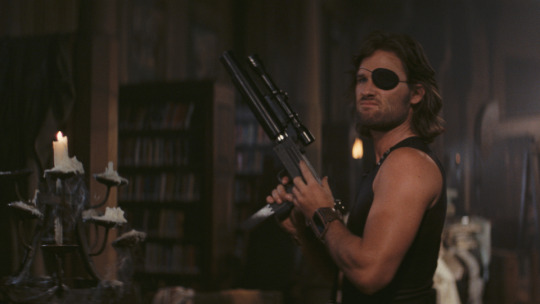
6. Escape from New York (1981)
When it comes to actors connected to directors, it’s usually not long before the pairing of Kurt Russell and John Carpenter comes up, and Escape from New York marks the genesis of this cinematic bond. With his traditional good looks, no-nonsense attitude and penchant for sharp wit, Russell was the perfect leading man for Carpenter’s vivid cinematic exploitation ventures. As for Escape from New York, the city had yet to undertake its Disneyfication of the 1990s, and the movie stands as a bleak vision of what the crime and moral dissonance of the city (and era) could lead to if taken to the extreme. Creating the worst place in America as an inescapable pit to drop the President into immediately sets the stakes high, and with little to no background, we are given the one man seemingly capable of achieving against impossible odds in the form of Snake Pliskin. Like some kind of urban Mad Max, Escape from New York gets wilder and wilder as the minutes tick away, making it one of the most iconic New York films to date, and one of the strongest offerings from John Carpenter during his legendary run.


5. Halloween (1978)
The first of many John Carpenter classic films, and arguably the most iconic of the bunch. Three films in, John Carpenter not only managed to turn one of the biggest profits in independent film history, but he created one of the all time great movie monsters in Michael Myers. The film put Jamie Lee Curtis on a rocket to success, turning her from a burgeoning television hopeful to a certified rising Hollywood star in just one role. In terms of pure production, the trend of growth continued for Carpenter as his cinematography gained more freedom of expression, the performances from his actors and actresses felt more natural, and quite possibly most importantly, his scoring ability was hitting maximum resonance, with the main theme of Halloween being equally as iconic as Michael Myers himself. The film has become an October staple for the masses, but manages to be enjoyable any time of the year due to its sheer ability to entertain and frighten audiences. If one were looking for a singular example of the John Carpenter aesthetic, Halloween stands out as a smart choice. Bonus points to John Carpenter for giving the Howard Hawks produced version of The Thing a shoutout two whole films before remaking it.


4. In the Mouth of Madness (1994)
Films about collective psychosis are nothing new… be they fodder for popcorn consumption such as Fallen or Identity, or teetering on the realms of art like Jacob’s Ladder, they are always a strong foundation for something memorable. Maybe that’s why In the Mouth of Madness seems at once exciting and familiar while watching it, as collective psychosis provides John Carpenter with plenty of ingredients to make his trademark-worthy best. Building an entire referential lore around fictional fiction writer Sutter Cane builds all kinds of abstract immersion layers to explore, especially with direct references (and delightful digs) at Stephen King and his Multiverse. Sam Neill and Julie Carmen take us by the hand and yank us through the innovative twists and turns with wonderful chemistry, with Neill giving an especially cavalier performance. The film has a billion and a half production touches that put the creep factors on overdrive, with some of the directing choices nearing the realms of Lynchian. It’s also a nice touch to hear Carpenter back in the scoring chair (even in a shared capacity). Films like this one aren’t done justice via rumination, review or commentary… it’s best to just dive in and deal with the repercussions on the other side of it all.

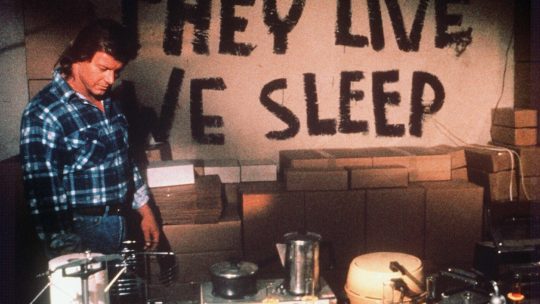
3. They Live (1988)
John Carpenter has made some amazing films in his time, but there are a small chosen few that contain genius-level writing and execution. Of this upper class of films, it’s arguable that They Live is both the most entertaining and the most thought provoking in terms of what it is saying (not to mention how much more relevant that message has gotten over time). A damning examination of capitalism, mass consumption, class divides, media influence and the use of police state tactics, Carpenter paints his science fiction with bold strokes of relevant facts that many often choose to ignore. The action in the film is top notch (including quite possibly one of the best fight scenes ever captured on film between Roddy Piper and Keith David), the makeup work on the aliens is instantly iconic, and the story not only sticks with you, but contains aesthetic elements reminiscent of Jenny Holzer’s influential artwork while being used for an identical purpose. If this list centered solely on John Carpenter minor box office successes that became top tier cult classics, They Live would likely occupy the top spot.


2. The Thing (1982)
The Thing is one of those movies that works on so many levels that it’s hard to fathom. The shorthand used to set up the story gives you a clear understanding of the situation with minimal use of exposition that is replaced by loads of character and world building. The threat is initially unclear, but the indication of its eventual impact kicks off the film with context that is only understood after your first complete viewing. John Carpenter turned over the scoring helm to Ennio Morricone, perhaps the only individual who could score a Carpenter film better than Carpenter himself, and the results are classic. The special effects work is brilliant, as it is not only initially shocking to see the terrifying transformations the creature undertakes, but it is deeply traumatic in a way that sticks with viewers permanently. Carpenter could not have asked for a better ensemble cast, especially considering that it seems like everyone came prepared to play team ball rather than try and outshine one another. It’s always fascinating to me that this film was widely rejected both critically and at the box office upon release, as it took me way too long to get around to this one (and I was only 3 at the time of release). I’ve always encountered nothing but deep fandom for the film, and rightly so, as this film is a masterpiece that deserves every piece of praise it receives.

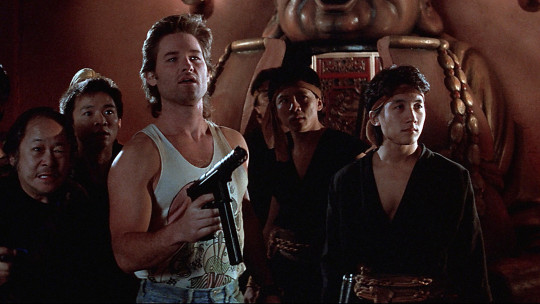
1. Big Trouble in Little China (1986)
What doesn’t this film do right? Kurt Russell is giving his all as Jack Burton, and the film beautifully wraps itself around him in a hurricane of action-based slippery slopes. Setting the film in San Francisco automatically gives it a memorable aesthetic, and locking down the majority of the film in iconic Chinatown is nothing but cinematic gold. We’re told that we’re going to get an unbelievable story, then we meet our everyman that will guide us along on our journey, but very quickly his expectations (and by extension, ours) are blown clear out of the water, and things continue to escalate at an exponential rate. Memorable runs in high quantity and quality for this venture… some of the most quotable John Carpenter film lines come from Big Trouble in Little China, his score for the film ranks high among the canon, the special effects are electrifying (pun intended), the action is high octane, and the martial arts is treated with complete respect in its presentation. Outside of They Live or Vampires, this is arguably the most fun film of the Carpenter collection, and is almost guaranteed to turn the unfamiliar into fans.
#ChiefDoomsday#DOOMonFILM#JohnCarpenter#DarkStar#AssaultOnPrecint13#Halloween#TheFog#EscapeFromNewYork#TheThing#Christine#Starman#BigTroubleInLittleChina#PrinceOfDarkness#TheyLive#MemoirsOfAnInvisibleMan#InTheMouthOfMadness#VillageOfTheDamned#EscapeFromLA#Vampires#GhostsOfMars#TheWard
0 notes
Text
Sound of the Flute
Pairings: Park Jimin x Reader
Genre: Dark Fantasy Au?
Words: 1.5K
Description: As requested by anon: “Jimin scenario based off the lyrics of pied piper. no matter how hard she tries not to, she follows the sound of the flute and falls in love with him not knowing that shes going to meet an ill fate?? ”
A/N: I really don’t know if this is what you had in mind lol, but thank you for the request! And hopefully it’s at least semi-decent :)

Legend has it that there is a mysterious man who stands on the bridge by the river each night and plays a mystical ballad on his long silvery flute. It’s a melody so eerily captivating that all those who listen to its seducing tune gravitate toward him like magnetic particles drawn to an iron core, despite knowing the risk of no return.
“This is no fairytale, it’s a-”
“Ok, Seokjin, stop” You get up abruptly from the couch, ready to head to bed. “This is stupid. You’re just trying to fuck me up and disrupt my beauty sleep.”
“It’s not even supposed to be scary.” He defends. “It’s an intriguing story.” He shrugs, crossing his arms. “You guys were the ones who wanted me to think of something to talk about.”
“And that’s what you thought of?” Taehyung looks at the older male with a bored expression.
“It’s actually a true story.” Namjoon cuts in, clearing his throat and ready to give a historical lecture.
“Yeah, I don’t want to hear it” You wave it off. “I’m going to bed.”
You were starting to think vacationing in Europe with three of your best friends was not the greatest of ideas. For one, Taehyung just likes to do his own thing half of the time, not caring about the time of day or getting lost forever. Namjoon never fails to lose his passport every five seconds and Seokjin…well he clearly just likes to spew shit out of his mouth that he thinks is intriguing or funny. There was just something off about the whole thing, and you can’t really put a finger on what exactly. You think it might just be the jet-lag you haven’t gotten over yet, or maybe Seokjin’s creepy story actually did hit a sensitive spot, which you still haven’t figured out how or why since those kind of things usually don’t bother you.
Getting some shuteye should help, so you wash up and crawl into bed.
But it wasn’t long before you found yourself waking up in the middle of the night. The sensation was strange because you’re usually able to get through at least one REM cycle before your slumber is disturbed, but a glance at the clock on the wall told you it hadn’t even hit 12am yet.
Then you hear it.
A song that drifts through your partially opened window, carried by the cold wind at the cusp of midnight. And you were fully aware that you were making an idiotic decision to actually tip-toe downstairs and out the front door to follow the sound, but why couldn’t you stop?
The night is chilly, but your cheeks feel flushed. The song is getting louder, and you can see the shadowy figure sitting on a bench under the tree, a long rod held up to his mouth, glistening under the street light.
As you approach him, you notice his body twitch and the music stops as he lowers the flute and turns around.
Your breath hitches in your throat, caught between the silence hanging in midair and the way his gaze settles on you. His skin is pale and translucent, features elf-like with large almond eyes and full lips. He was nothing short of beautiful, but his aura was unnerving to say the least.
“You’re like the person in the story,” You point out, not really thinking before you spoke because why in the world would you expect this stranger to know what story you’re even referring to? Heck, you don’t even know why that was the first thing that popped into your head, but you put full blame on Seokjin.
“What story?” He cocks a brow, lips forming into a sly smile and eyes glimmering under the moonlight as if he knew the answer before the words escaped your lips.
“The one about the Pied Piper.”
“Because of this?” He holds the musical instrument up, eyes scanning along it’s length and admiring how elegant the object looked under the starlit sky.
You nod, keeping your eyes trained on his actions.
He giggles, a sound so bubbly and beautiful that it makes you wonder if he’s human.
“So anyone who plays the flute has the purpose of luring children to their deaths?”
“At night.” You correct, surprised that he knew the story so well. Coincidence? Or was the tale really that popular?
He laughs, throwing his head back before composing himself once again. “Excuses.”
“What?” You frown, shaking your head as if you had misheard him. “What are you talking about?” Confusion is starting to lace itself in the foundation of your otherwise misleadingly calm features, the growing fear hidden behind a poised facade.
He stands up and walks towards you, eye piercing into yours as he leans down leisurely and whispers into your ear. “You wanted to meet me.”
“W-What makes you say that?” Your voice is shaking now, but you’re rooted in the spot.
“The fact that you came, and the fact that you are still here.”
You can feel his warm breath slither down your neck, sending tingles across your shoulders. The scent of his body is almost even more compelling than the song he was playing earlier, and you can feel something intangible compel you soak in the warmth of his presence, the mesmerizing sight of his otherworldly beauty. You stare at the way his Adam’s apple bobbles up and down, the smooth skin of his neck tender and rippling in waves as he swallows gently, and in that compromising position you sense this unnatural yearning to lean forward and kiss him, to taste what is already teasing at the tip of your tongue, what your body is begging for more of.
“Ummm, ok, I’ll just go then.” Your voice is unsteady and your breathing is erratic, but you’ve managed to break out of your momentary trance.
He takes a step back, seemingly unaware of your internal distress. “Be my guest.” He makes a motion to make way for you.
Still staring at him cautiously, you don’t want to make this encounter stranger than it already is, queerer than it actually was, so your mind chooses to ignore the fact that all of this was bone chillingly terrifying, but for some disturbing reason you’re entirely convinced he’s not dangerous, or at least that’s what you’re mind chooses to believe.
Swallowing once again, you turn to leave, legs feeling heavier than they had when you arrived at the scene not long ago. But before you’re too far away, you turn around and voice one last question. “What’s your name?”
“Park Jimin” He smiles, eyes curving into slits, and it’s almost angelic, but not quite because the mischievous glint in his eyes is deceivingly innocent for someone who plays with temptation like it is a game.
…
You try to close your eyes and ignore it, but you physically can’t. Why? Why was the sound so hard to dismiss. Why were you mentally aware of the situation and yet unable to control your decisions?
You sit up in your bed, eyes darting towards the moon hanging in the opaque night sky, round and luminescent like it was urging you to throw on your jacket and escape into the night for a second time. And you cooperatively oblige.
“Are you here every night?”
He flashes you a knowing smile, lowering the flute. “No.”
“Why are you here?”
He lets out an airy chuckle, running a hand through his fluffy locks of hair. “Do you want me to leave?”
“No” The syllable comes out automatically, and you swear it’s not what you meant to say. You divert your eyes, but maybe that was a bad decision because you don’t notice him approach you until you look up and realize his face is only an inch away from yours.
“I know you can’t help it.” He whispers, soft and breathy, making your head spin with confusion and your heart burn with the flames of desire. “Don’t reject me.”
“I-I”
“Shhhh” He hums, moving even closer and placing his hands on your hips as he catches your mouth with his lips. You are initially hit with shock, but his scent is sedative like a drug and he tastes like nothing you can describe that is of this world, sweeter than sugar, softer than cotton. It makes you feel so safe, so comfortable, and so eager to give in and let whatever effect he has on you take over completely. And you know if he’s strong enough to control you like this, he’s certainly strong enough to ruin you completely, but you also don’t care.
Jimin breaks the kiss slowly, suckling on your lower lip one last time before letting go and allowing you to breath again.
“If you come with me, we can be together forever.” He murmurs, eyes gazing into yours with an intensity that you cannot refuse.
So you follow him, pulled by the pleasure his presence has on you. He was ethereal, so saccharine and irresistible, like the most coveted fruit on the forbidden tree. It was not long before you’ve reached the end of the journey, the moon still waiting for your next action.
You stare at the dark opening, not even capable of questioning what lies down there. All you can hear is the sound of the flute, rising up from the bottomless pit and drifting to your ears, calling you forward into the depths of your paradise.
“You love me, don’t you?”
The next thing you know, you’ve jumped, welcoming your end willingly.
...
#jimin scenarios#bts scenarios#jimin fanfic#bts fanfic#fantasy au#bts pied piper#i've never written a fantasy au so idk what this is#apologies in advance#but#thanks for the request!#requested
90 notes
·
View notes